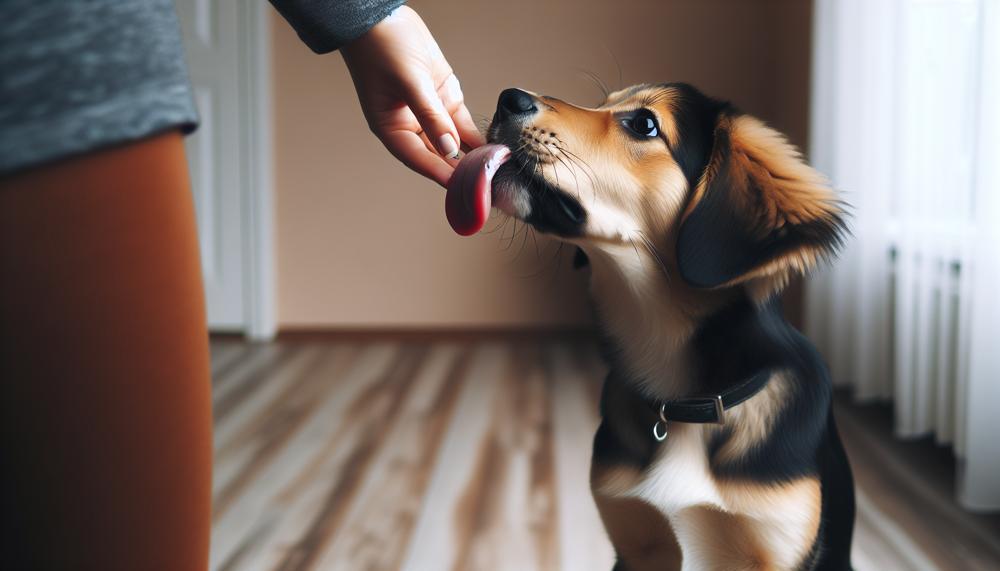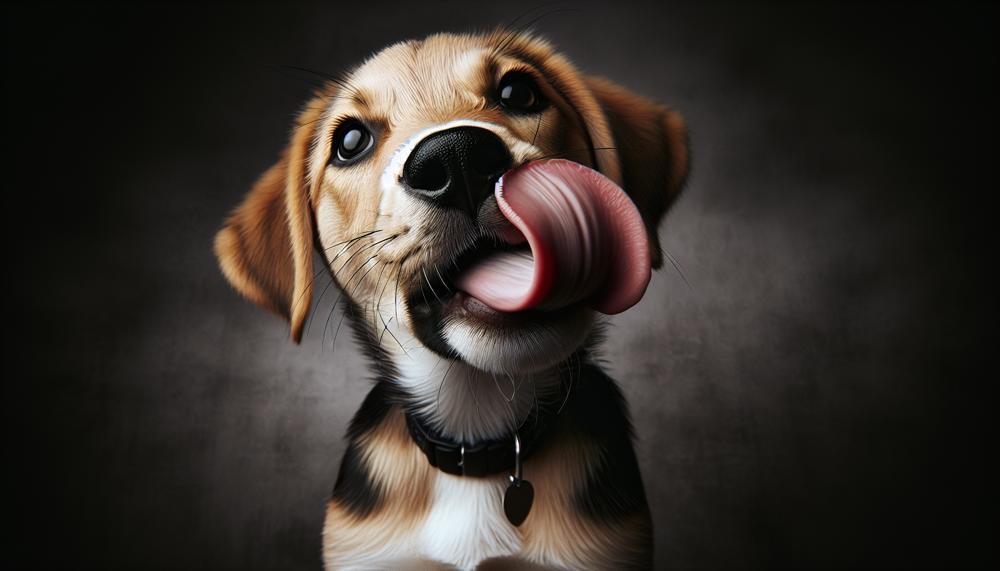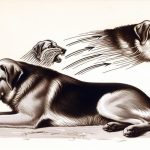Have you ever wondered why your dog loves to lick your legs? It may seem like a simple sign of affection, but there’s more to this behavior than meets the eye. In this blog post, we’ll delve into the fascinating reasons behind why dogs engage in this seemingly strange behavior.
- One explanation for this behavior lies in a dog’s innate grooming instincts. Licking is a way for dogs to clean themselves and their pack members.
- Another reason could be linked to a dog’s sense of taste. Our skin contains salt, which dogs may find appealing and tasty.
- This behavior can also be a form of submission and respect towards you as their pack leader.
- Additionally, licking can serve as a form of communication for dogs, as they use body language and actions to express their needs and emotions.
- Interestingly, both humans and dogs release endorphins when engaging in licking behaviors, creating a sense of comfort and happiness for both parties.
So next time your furry friend starts licking your legs, remember that it’s not just an act of love but rather a complex behavior with multiple underlying reasons.
Keep reading to learn more about the intriguing behaviors of our canine companions.
Why Does My Dog Lick My Leg?
Table of Contents
- 1 Why Does My Dog Lick My Leg?
- 2 Why Does My Dog Lick My Leg? Possible Reasons and Interpretations
- 3 Expressing Affection: How Licking is a Form of Communication for Dogs
- 4 Seeking Attention or Rewards: Training Your Dog to Stop Excessive Licking
- 5 Boredom and Anxiety: Finding Ways to Distract and Alleviate Licking Behaviors
- 6 Grooming and Exploration: The Instinctual Reasons Behind Your Dog’s Licking
- 7 Medical Interventions for Excessive Licking in Dogs
- 8 Conclusion
There are a variety of possible explanations for why your furry companion may be giving your leg a good lick. These include showing submission, expressing anxiety or stress, communicating with you, seeking attention or affection, or even a medical issue. It’s crucial to pay close attention and understand your dog’s behavior in order to determine the root cause and address it accordingly.
Potential causes for your canine’s leg-licking tendencies:
| Cause | Description |
| Submission | Licking is a way for dogs to show submission and respect towards their owners, who they see as the leaders of their pack. |
| Anxiety or Stress | Excessive licking can be a coping mechanism for dogs experiencing anxiety or stress, as it releases endorphins that help them relax. |
| Communication | Dogs have a keen sense of smell and may lick their owner’s leg to gather information about them, such as where they have been and who they have interacted with. |
| Seeking Attention or Affection | Dogs may lick their owner’s leg as a means of seeking attention or affection, especially if they’ve learned that it’s an effective way to get what they want from their owners. |
| Medical Issue | In some cases, excessive licking of the leg could indicate an underlying medical issue such as allergies, skin irritations, or dental problems. It’s essential to consult with a veterinarian to rule out any potential health problems. |
No matter what the reason may be behind your dog’s leg-licking behavior, it’s crucial to address it before it becomes a habit. Ignoring the behavior and not rewarding it with attention or affection can help discourage it.

Providing toys or engaging in activities with your dog can also serve as a distraction to prevent boredom-induced licking. Consistent walks and one-on-one time can also help alleviate any anxiety that may be causing the behavior.
If the issue persists, seeking advice from a vet for medical or non-medical interventions may be necessary.
Why Does My Dog Lick My Leg? Possible Reasons and Interpretations
These can include:
| Reason | Possible Interpretation | Recommended Action |
| To alleviate pain or discomfort in the area | Dogs may lick their leg if they are experiencing discomfort or pain in that area. This could be due to an injury, inflammation, or skin irritation. Licking can provide temporary relief and comfort to the dog. | If the licking is excessive and causing harm to the skin, it is best to consult a veterinarian to identify and treat the underlying issue. |
| To groom themselves | Dogs may lick their legs as a way to groom themselves, especially if they are unable to reach certain areas with their tongue. This behavior is more common in long-haired breeds. | If the licking is not excessive or causing harm, this behavior is normal and does not require intervention. |
| Allergies or skin problems | Dogs may lick their legs due to allergies or skin problems such as hot spots, dermatitis, or fungal infections. Licking can provide temporary relief and help soothe irritated skin. | A veterinarian should be consulted to diagnose and treat any underlying allergies or skin conditions. |
| Anxiety or boredom | Licking can be a self-soothing behavior for dogs experiencing anxiety or boredom. It can also be a way for them to seek attention or rewards from their owners. | Providing mental and physical stimulation through walks, playtime, and interactive toys can help reduce anxiety and boredom in dogs. Ignoring the licking and not rewarding it with attention can also discourage the behavior. |
| Display affection | Dogs may lick their owner’s leg as a sign of affection, similar to how they might lick another dog’s face as a friendly gesture. | If the licking is not excessive or causing harm, this behavior is normal and does not require intervention. However, setting boundaries and redirecting the behavior can be helpful if it becomes too frequent or bothersome. |
| Mark their territory | Licking can also be a way for dogs to mark their territory and communicate with other dogs or animals in the household. This behavior is more common in male dogs. | Providing designated areas for the dog to mark and consistently reinforcing good behaviors can help manage this behavior. |
Expressing Affection: How Licking is a Form of Communication for Dogs
Dogs use licking to communicate with their human companions, and it can be a powerful tool in expressing affection and strengthening their bond. Licking is a natural behavior that puppies learn from their mothers as a way to show submission and seek attention. As they grow, dogs continue to use licking as a means of conveying their emotions and needs to their owners.
One of the main ways in which dogs express affection through licking is by grooming. This behavior imitates how a mother dog would clean her puppies, and it can be seen as a demonstration of love and care. Dogs may also lick their owners’ faces or hands to show affection and seek attention. This is especially common when owners return home after being away for some time, as it is a way for dogs to express their joy and strengthen their bond with their human companions.
Licking can also serve as a means for dogs to mark their territory and show ownership over their owners. By licking, dogs leave their scent on their owners, which is a way of claiming them as part of their pack. This behavior can also be seen as a sign of protection and loyalty towards their owners.
Moreover, licking can stimulate the release of endorphins in dogs, which can help them feel more relaxed and content. This is why dogs may lick themselves or their owners when feeling anxious or seeking comfort.
Seeking Attention or Rewards: Training Your Dog to Stop Excessive Licking
To successfully train your dog to stop excessive licking and seek attention or rewards in a more appropriate manner, it is crucial to comprehend the reasons behind their behavior. Dogs may excessively lick due to boredom, anxiety, or a desire for attention.
By addressing the root cause and offering alternative behaviors, you can effectively train your dog to stop excessive licking.
- Understanding the reasons behind excessive licking is the first step in training your dog. Boredom, anxiety, and a desire for attention are common causes of this behavior. By identifying the specific reason for your dog’s excessive licking, you can tailor your training approach accordingly.
- Ignoring the behavior is a powerful technique in training your dog to stop excessive licking. When your dog licks you for attention, stand up and leave the room. This shows them that their behavior does not result in getting what they want. With consistent practice, your dog will learn that their behavior has no reward and will eventually stop.
- Rewarding good behavior is another effective strategy in training your dog. When your dog is well-behaved and not excessively licking, praise them and give them attention. Positive reinforcement encourages good behavior and helps your dog understand what is expected of them.
- Reinforcing alternative behaviors is also crucial in training your dog to stop excessive licking. Instead of licking, train your dog to perform other commands such as sitting or lying down. You can also redirect their licking to objects or toys. This teaches them that there are other appropriate ways to seek attention.
- Providing mental and physical stimulation is essential in preventing boredom and anxiety, which are common causes of excessive licking. Engage your dog in activities and games that stimulate their mind and body. This will help reduce boredom and anxiety, leading to fewer instances of excessive licking.
If the issue persists or worsens despite your efforts, seek professional help from a veterinarian or animal behaviorist. They can provide further guidance and advice on how to address your dog’s excessive licking behavior.
| Step | Description | Example |
| 1 | Understand the reasons behind excessive licking | Boredom, anxiety, seeking attention |
| 2 | Ignore the behavior | Leave the room when your dog licks you for attention |
| 3 | Reward good behavior | Praise and give attention when your dog is well behaved |
| 4 | Reinforce alternative behaviors | Train your dog to perform other commands and redirect their licking to objects or toys |
| 5 | Provide mental and physical stimulation | Engage your dog in activities and games that stimulate their mind and body |
Boredom and Anxiety: Finding Ways to Distract and Alleviate Licking Behaviors
It is crucial to pay attention to your dog’s body language and behavior patterns in determining whether their excessive licking is a result of boredom or anxiety. If you notice repetitive licking along with other signs of stress, such as pacing, panting, or hiding, it could be a sign of anxiety.
On the other hand, if your dog seems restless and engages in activities like chewing or digging, they may be bored and using licking as a way to entertain themselves.
To distract and alleviate your dog’s licking behavior, here are some strategies you can try:
- Provide mental and physical stimulation: Bored dogs often resort to excessive licking as a means of entertainment. To prevent this, ensure they get plenty of exercise, playtime, and mental stimulation through puzzle toys.
- Train and redirect: Positive reinforcement techniques and working with an animal trainer can help redirect your dog’s licking behavior to more appropriate activities. This may involve teaching them a “leave it” command or offering alternative ways to release their energy, such as playing fetch or going for walks.
- Use deterrents: Some dogs may respond well to deterrents like bitter apple spray or noise-making devices when engaging in excessive licking. However, use these products sparingly and never punish your dog for licking.
- Address underlying issues: If your dog’s licking behavior is rooted in underlying anxiety or stress, it is essential to address the cause. Consult with a veterinarian for medical interventions or seek help from a behaviorist to develop a treatment plan.
Grooming and Exploration: The Instinctual Reasons Behind Your Dog’s Licking
Grooming and exploration are natural behaviors for dogs that have been passed down from their wolf ancestors, serving various purposes related to their instincts and communication. Dogs engage in grooming to maintain social connections within their pack, establish a hierarchy, and express affection, submission, trust, and respect.
Along with keeping themselves clean and free of parasites, grooming also triggers the release of endorphins, providing a sense of peace and comfort.
As owners, it is important to understand and appreciate this behavior to strengthen the bond with our furry companions.
However, excessive licking can be a sign of underlying issues that need to be addressed. It could be indicative of skin allergies or behavioral problems such as anxiety or boredom. As responsible pet owners, it is our responsibility to pay attention to our dog’s grooming habits and address any concerning behavior.
So, grooming is a vital aspect of a dog’s life that serves numerous purposes related to their instincts and communication.
Medical Interventions for Excessive Licking in Dogs
There are many different ways to treat excessive licking in dogs, depending on the underlying cause. Some of these medical interventions may include:
- Antibiotics: When a skin infection is causing the excessive licking, systemic antibiotics may be prescribed to eliminate the infection.
- E-collar: An E-collar, also known as a buster collar, can be used to prevent further skin damage caused by excessive licking. This is especially helpful for dogs with compulsive licking behaviors.
- Prescription medications: Dogs with behavioral disorders may benefit from prescription medications, such as antidepressants or anti-anxiety drugs, to reduce their excessive licking tendencies.
- Omega-3 fatty acids: Adding omega-3 fatty acids to your dog’s diet can help reduce inflammation and itching, which can trigger excessive licking.
- Calming products: In addition to antihistamines, products like calming shampoos, topical mousse, or wipes can also be used for over-the-counter therapy.
- Medicated shampoos and conditioners: These can be effective in reducing itching and controlling secondary infections in dogs with skin allergies or other skin conditions.
- Redirecting focus: Providing alternative activities for your dog to keep them occupied can help redirect their focus away from excessive licking.
- Positive reinforcement training: Using positive reinforcement techniques when training your dog can help discourage excessive licking by rewarding desired behaviors.
- Not reinforcing the behavior: It’s crucial not to reinforce your dog’s excessive licking by giving them attention when they exhibit this behavior. This will only strengthen the unwanted behavior.
By closely collaborating with your veterinarian and utilizing these medical interventions, you can successfully decrease your dog’s excessive licking and improve their overall well-being.
Also Read: Why Does My Dog Bring Me Toys?
Conclusion
In conclusion, it is clear that the act of your dog licking your leg goes beyond a simple display of affection.
It is a multi-faceted behavior influenced by their natural grooming instincts, taste preferences, and communication skills. From submission to seeking information or finding comfort through endorphins, there are various reasons for this behavior.
However, excessive licking can also be a red flag for underlying issues such as anxiety or medical conditions that require attention. By understanding these reasons and addressing them appropriately, we can strengthen our bond with our four-legged companions and ensure their well-being.
Remember to observe your dog’s body language and seek professional help if necessary to effectively manage their licking behaviors.






